Nixeus NX-VUE27 27" Monitor: High Resolution for the Masses
by Chris Heinonen on September 20, 2012 6:10 PM ESTColor Quality
I didn’t have a driver CD or anything else to use for a default ICC profile for the Nixeus, so the initial measurements were done at 200 nits in standard mode, as it was the closest to the D65 white point of the sRGB standard.
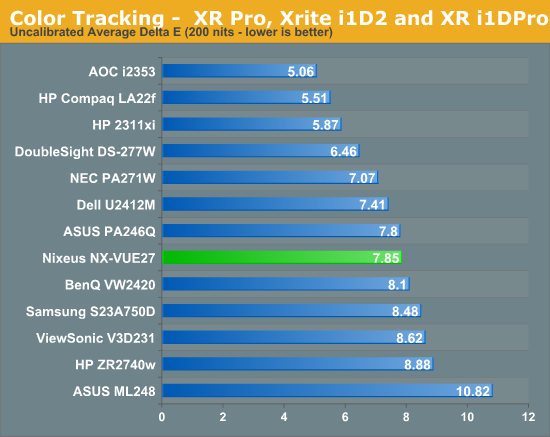
Straight out of the box the results are about par for a 27” display. With an average dE across the Gretag Macbeth chart of 7.85, this falls in as worse than the NEC and DoubleSight models I saw, but better than the HP that has been my favorite 27” to this point for its balance of price and performance.
The main issue with the uncalibrated performance is the grayscale numbers. Most of us have white backgrounds on webpages, Word, Excel, email, and all our other programs, so an error here is more visible that a shade of blue might be. This isn’t any worse than most other displays I have reviewed, but I wish it were better.

Once calibrated, the numbers really fall into line with everyone else. The average dE is 1.78, which is almost identical to the HP ZR2740w that scored 1.76. The grayscale error comes down to be between 1.0 and 1.5 across the whole scale, so you really won’t be able to notice a color tint at all. The errors all occur in those shades of blue that are always troublesome, but the rest of the numbers really fall into line here. This is impressive considering this display costs $300 less than its competitors.
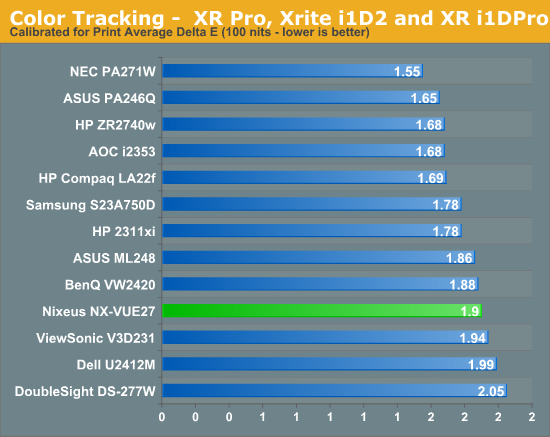
With print work the numbers aren’t quite as good. Set for 100 nits, we get a dE of 1.90 that begins to lag behind the HP, and really lags behind the far more expensive NEC PA271W. Nothing here is horrible, but it does fall a little behind the competition here. Most likely it won’t be noticeable in real world use, but for professionals that often want a dE of 1.0 or less, having a dE of closer to 2 might not cut it.
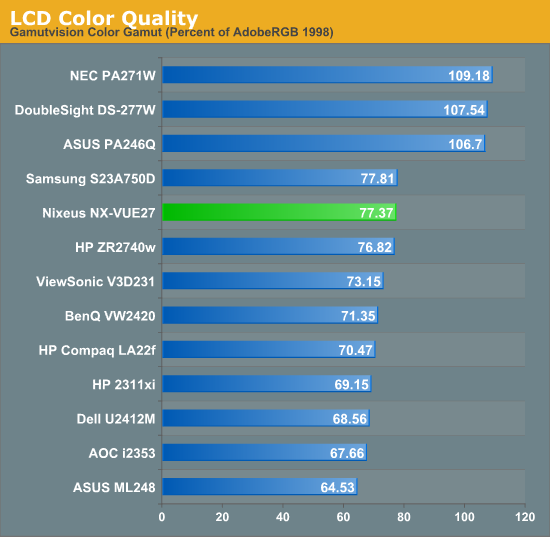
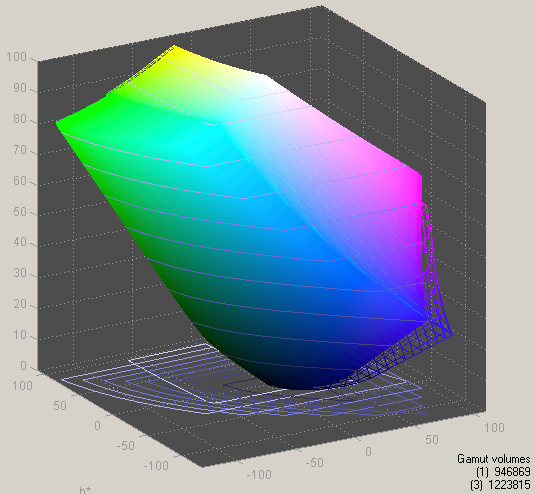
The coverage of the Nixeus panel is really no surprise at all. Since all 27" displays seem to be using a panel from LG with either LED or CCFL backlighting, it's the backlighting that determines the color gamut. Here we are incredibly close to the same coverage as the HP, both of which are covering virtually the entire sRGB gamut. As before, if you want a larger gamut, you'll need to get a CCFL or RGB-LED backlight; either one will push the cost up significantly right now, as well as the power consumption (and in the case of CCFL, the size).



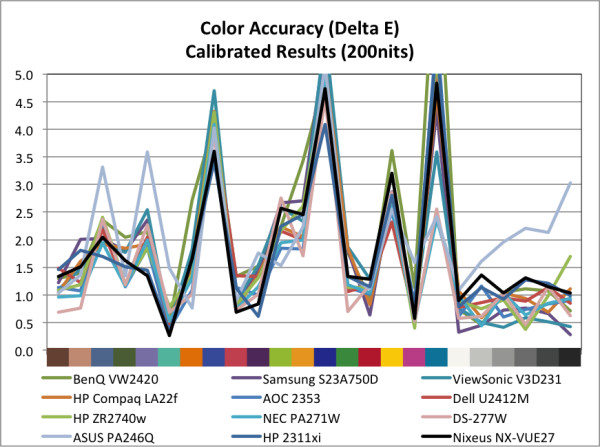
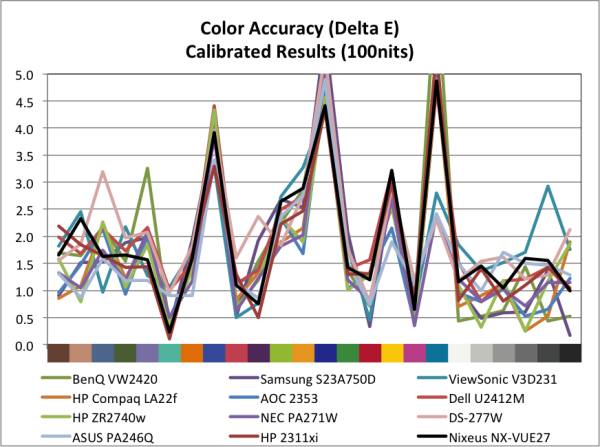








66 Comments
View All Comments
magreen - Thursday, September 20, 2012 - link
Especially given that there appears to be a real surplus of compute power in computers these days. The vast majority of users have no need for the compute power an i7 can deliver nor what most discrete GPUs can deliver. It's time to harness that power to finally give us resolution independent displays!peterfares - Thursday, September 20, 2012 - link
Windows fully supports DPI scaling since Vista. Most Microsoft programs fully support it and a few third party ones do, too. You can also try forcing high DPI mode on unsupported programs and see which ones work. Otherwise you can run them at their original pixel size or you can pixel scale them.Microsoft made a small push for higher DPI screens back during Vista's launch (along with hybrid hard drives) and it's only now when screens are finally moving up in DPI (look at the new laptops and tablets with 13" 1080p screens). Hybrid hard drives are also coming into play, though it's a bit late since SSDs are becoming big and cheap enough to completely replace them. Vista was just far ahead of its time.
cosmotic - Friday, September 21, 2012 - link
"vista was just far ahead of its time"Yeah, *thats* what vista was.
Malphas - Monday, September 24, 2012 - link
Actually it was, try Vista again today and you'll find it a near identical experience to Windows 7. The reason it was so awful at the time was due to underpowered hardware (made worse by the Vista Ready scheme Microsoft stupidly went along with to appease OEMs), incompatible hardware and software, buggy third party drivers, software that didn't play nice with UAC, etc. The actual OS itself is sound and again only cosmetically different from Windows 7, which received near universal praise.Penti - Friday, September 21, 2012 - link
Readyboost is still horrible and should die, seriously just give me an mSATA SSD + HDD if cheap storage is needed instead of 5400 rpm drives and small sub 64GB SSDs for caching. It's worse then a fast HDD. DPI-scaling is by no means an nice and clean way of scaling elements in Windows, not even all Microsoft apps support it. Though it's standard to have it scale on OEM-PCs since a long time now. Metro still scales horrible though.madmilk - Thursday, September 27, 2012 - link
It supports it in basically the same way the retina Macbook does (assuming Vista-style scaling): show natively high-res apps at full resolution, and scale up the rest.The difference is, Microsoft hasn't gone out and made noise about it, so pretty much everyone's apps are just using ugly scaling.
Sabresiberian - Friday, September 21, 2012 - link
"Resolution" has been perverted since LCDs came out. It used to be tied to pixel density. So, correctly speaking cell phones already have higher resolutions than monitors.;)
jeremyshaw - Thursday, September 20, 2012 - link
Hello,I've noticed you mentioned HDMI 1.4 support in the specifications list. Does that mean an AMD GCN or Intel Ivy Bridge (do the Ivy Bridge drivers support that, yet?) can output, via a HDMI output, a 2560x**** image at 60Hz?
peterfares - Thursday, September 20, 2012 - link
It's been stated that this display supports those resolutions over HDMI as long as you have a device capable of sourcing it. I don't know what can source it, if anything, yet.atotroadkill - Thursday, September 20, 2012 - link
From what I can find on the web, if you are using the CPU's embedded GPU for the HDMI output then no - only displayport can.To power 2560x1440 over HDMI you may need a descrete Nvidia 600 series card.